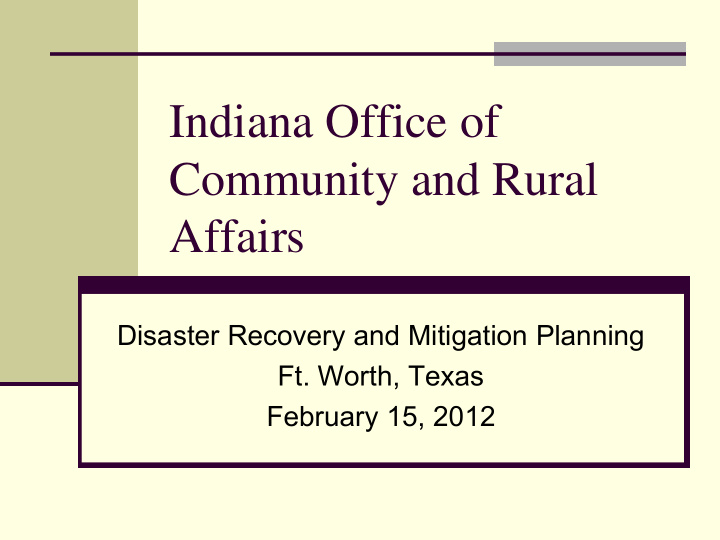



Indiana Office of Community and Rural Affairs Disaster Recovery and Mitigation Planning Ft. Worth, Texas February 15, 2012
Floods Indiana’s costliest hazard State ranks 5 th in annual median flood damages 2008 was particularly devastating.
Impacts on Indiana Communities Loss of life Evacuations Large scale property losses Large scale infrastructure damage 3 major federal Disaster Declarations in 2008 alone Agricultural effects
More Resilient Communities OCRA wanted to use funds made available under the IKE Supplemental to help Indiana communities recover and become more resilient to future flood hazards.
USACE Silver Jackets The program's primary goals are to: Create or supplement a mechanism to collaboratively address risk management issues, prioritize those issues, and implement solutions Increase and improve risk communication through a unified interagency effort Leverage information and resources, including providing access to such national programs as FEMA's RiskMAP program and USACE's Levee Inventory and Assessment Initiative Provide focused, coordinated hazard mitigation assistance in implementing high-priority actions such as those identified by state mitigation plans Identify gaps among the various agency programs and/or barriers to implementation, such as conflicting agency policies or authorities, and provide recommendations for addressing these issues.
Planning Projects Seven projects funded through CDBG Disaster Recovery, administered by OCRA Each designed as a forward looking mitigation activity to help Indiana communities become more resilient to flood hazards Also leveraged other fund sources (i.e. USACE, USGS, State & local funds) $13,400,310 allocated for recovery/mitigation planning projects
The Projects National Hydrography Dataset Orange County Flood Response Model Flood Inundation Mapping Fluvial Erosion Hazards Statewide LIDAR RiskMAP Indiana Floodplain Information Portal
National Hydrography Dataset NHD is hydrologically connected, allowing for its use in detailed hydrologic modeling This GIS layer is essential to quality floodplain mapping, and has many uses Current resolution is compiled at a scale of 1:24,000 Project resolution will be compiled at a scale of 1:2,400 or better Stream reaches will be captured up to a 6 acre watershed limit
Orange County Southern Indiana County with a long history of flood damage Compounded by complex karst topography
Orange County The ISJ member agencies are developing a hydrologic response model that will predict how streams respond to rainfall This will help county communities develop mitigation strategies and plan growth to minimize flood damages INDOT, Local, USACE, and USGS funds were leveraged to install 5 streamgages for early flood warning and to calibrate the model
Flood Inundation Mapping This project is building flood inundation map “libraries” tied to 23 USGS streamgages and collocated NWS flood forecast points Now instead of just getting river levels at a point on a stream, the estimated flood depth and extent throughout the community can be seen. A planning, response, recover, and mitigation tool
Web Portal http://water.usgs.gov/osw/flood_inundation/
Fluvial Erosion Hazards (FEH) Inundation is not the only flood hazard Erosion hazards are significant and can cause more dollar damage Transportation infrastructure particularly vulnerable
Fluvial Erosion Hazards Pose a significant risk to IN communities yet we did not have the tools for planning and mitigation. This project seeks to develop those tools.
FEH Deliverables FEH Mapping for selected streams Silver Jackets facilitated presentations and workshops Assessment & mitigation tools to help communities identify and mitigate FEH impacts
Statewide LIDAR Project Light Detection And Ranging (LIDAR) High resolution ground elevations (DEMs) Ancillary data – i.e. floodplain mapping Better imagery Planning/Development Zoning Studies
Risk MAP FEMA’s new mapping initiative, mainly focused on enhancement of information of streams that are already mapped on the Digital Flood Insurance Rate Maps Approximately 12,500 miles of unmapped streams in Indiana Project will map approximately 3,200 miles of unmapped streams and perform detailed studies of four stream reaches
Indiana Floodplain Information Portal (INFIP) INFIP operates as a web based portal that relates IDNR applications and databases to enhanced mapping solutions and information repositories. The portal includes a “Google Earth” type map of DFIRM floodplain information including an address finder Project will add four additional functions to the portal: enhanced reporting capabilities, a tool to detect floodplain status change, development of a hydrologic model mgmt system, and a module to display and gather high water mark information
Accomplishments Projects are on track to be completed in calendar year 2013 The projects are complimentary and will help provide a comprehensive approach to mitigation of flood hazards State & local hazard mitigation plans will incorporate the new products The scale of work would not have been possible without the inter-agency participation of Silver Jackets
Summary What would we do again? What was most challenging? What didn’t work? What would we change?
For More Information Kathleen Weissenberger IN Office of Community and Rural Affairs kweissenberger@ocra.in.gov (317) 232-1703
Recommend
More recommend